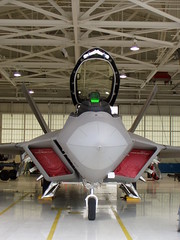AUVSI
Stay tuned.
Technology items that of potential interest to the ERAU community.
...[S]ome critics ask, why can't we cut the expensive Raptor in favor of the cheaper Lightning? While a fine bomb-hauler and (one hopes) a good multi-service airframe, the F-35 is a mediocre performer. Said 1st Fighter Wing commander Brigadier General Burton Field, "The problem with the F-35 ... is speed. It doesn't have the capability to supercruise. Speed lets us get inside the decision cycle of the bad guy."
For the most dangerous air battles and attack missions, F-35 squadrons will rely on F-22s for support. That's an unavoidable state of affairs when you design an airframe to replace slow- and low-flying Lockheed Martin A-10 Warthogs and Boeing AV-8B Harriers as well as light and flexible F-16s and Boeing F/A-18 Hornets. The F-35 is a compromise. Potentially a very successful compromise, but still ...
We've already sunk $25 billion into Raptor development. That money is irrecoverable. Further jets cost only around $115 million (perhaps twice as much as a new F-16) and will get even cheaper. We should get a good return on our investment. A good return, in my estimation, means a full fleet of at least 381 Raptors in 10 or more full-strength squadrons. That should guarantee air dominance for another 30 years or more.
In announcing the project in 2000, Boeing predicted that the market for inflight Internet access would be worth $70 billion over 10 years. But the company said Thursday that the number of passengers using the service on the 156 aircraft with 12 airlines amounted to little more than "low single digits" a flight. Boeing declined to say how much it costs to run the service.
The cost to airline passengers is $9.95 an hour or $26.95 for an entire flight, and revenue is shared between Boeing and the airlines.
Lufthansa, which operates 62 aircraft using the system, said that the maximum number of passengers ever connected at one time is around 40 a flight, usually on routes to North America and Asia.
"Given the usage level, we just didn't see the kind of numbers that add up to a business," said John Dern, a Boeing spokesman. "You could say it flew well technically, but it didn't fly so well as a business."
 Defense Tech (where else) has
Defense Tech (where else) has The U.S. Army's drone of choice, the Raven, is a 3-foot-long, camera-equipped miniplane that's "launched" when a soldier winds up and throws it. Once in the air, the Raven is controlled by a book-sized console that looks something like a 1980s-era Coleco football game. The screen at the top displays one of the drone's three video feeds, and the joysticks and buttons at the bottom pilot the craft. Operators can use the sticks to pilot the Raven like a model plane or just preprogram GPS coordinates for the drone to follow. There's even a button that automatically returns the Raven to its launch site.And more on Predator and Global Hawk sized planes.